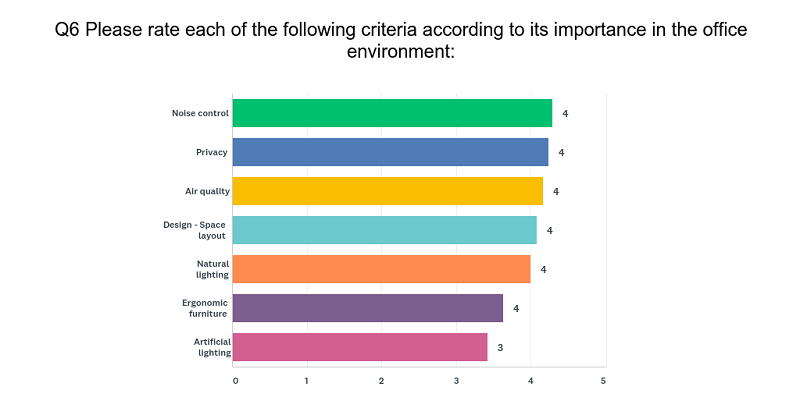This past spring, we surveyed a cross section of office workers and asked them to rate the most important factors in an office environment. Check out their ratings, and read on to find out more on the importance of each of these factors.
#1 Privacy
Privacy is the #1 perk most craved by over 86% of the office workers we surveyed. Part of this might be a backlash to open floorplan office models that focus on trendiness while overlooking the importance of privacy. But this doesn’t mean the trend can’t be your friend.
Activity-based workplace design uses a mix of open coworking space, semi-private, and private offices. Assigned work areas, private offices and suites with conference space, along with a social hub and café give office workers the best of both worlds – and the privacy they crave.
#2 Noise Control
Noise control in the office was ranked as the second most important environmental factor by our survey respondents.
Reducing noise levels in the office does take some planning in advance. But with enough thought, minimizing office noise can be easy to accomplish:
- Establish quiet zones in the office,
- Customize furniture to control workplace noise,
- Select ceilings that don’t bounce noise throughout the office,
- Use carpets and engineered flooring to absorb noise,
- Indoor plants can also absorb a surprising amount of noise in the office.
#3 Air Quality
A recent study by Harvard’s School of Public Health, SUNY Upstate Medical University, and Syracuse University found that people working in well-ventilated offices have higher cognitive function scores.
Nearly 84% of the office workers we surveyed ranked office air quality as an important or very important factor. There are two key benefits of having good air quality in an office:
- Cognitive abilities such as learning, remembering, and problem solving are improved,
- Physiological effects such as allergies, fatigue, headaches and respiratory problems are reduced.
There are several ways to improve the air quality in an office: keep indoor humidity low, maintain ventilation systems, keep air filters clean, and reduce the use of non-organic chemicals and cleaning solutions.
#4 Office Space Layout & Design
Designing a great office layout means combining furniture, lighting, and the different areas of the office space in a way that makes employees feel welcome and lets them get down to business right away. Over 80% of our survey respondents ranked office space layouts and design as being important or very important to their overall office environment.
There are five key aspects to consider when planning an environmentally friendly office design:
- Natural light and green plants to bring the outside in,
- Have the right amount of space and manage it efficiently,
- Combine online and offline storage solutions to reduce clutter and improve office cleanliness,
- Good quality, ergonomically designed furnishings,
- Welcoming and comfortable lobby area.
#5 Natural Lighting
Natural lighting in the office is another key factor in increasing productivity and worker health and satisfaction. Nearly 70% of our survey respondents agreed, ranking natural lighting in the office environment as being important or very important.
The five top benefits of having natural lighting in the office and workplace are:
- Better sleep, and no, not at the office! Workers who have natural lighting at work sleep better and longer at home, which translates to more brainpower at work.
- Reduces energy costs – letting in natural light from the great outdoors reduces electrical expense.
- Improves moods – natural lighting in the winter helps to reduce the changes in circadian rhythms that make people feel slow and sluggish during the darker wintertime months.
- Less eyestrain – even the best artificial lighting may not provide the same quality of illumination that natural light does.
- Increased productivity – a well-rested and happy staff means people are able to concentrate and remember more, which directly affects the business’s bottom line.
#6 Ergonomic Furniture
Ergonomics is the study of how best to change the workplace environment in order to help people perform better. Back in 1955 industrial designer Henry Dreyfuss and his firm applied the principles of ergonomics in the workplace by measuring factors such as peoples’ height, weight, range of motion, and vision.
This research discovered five top benefits of proper ergonomics in the workplace:
- Improves physical safety,
- Helps prevent musculo-skeletal disorders such as neck and back pain,
- Improves long-term health and well-being,
- Employers benefit by having higher-performing and more motivated staff,
- Ergonomic furniture and office solutions are easier to adapt to individual employee needs.
The office workers we surveyed agreed. Over 60% rated ergonomic furniture as being very important or important to their overall office environment.
#7 Artificial Lighting
Lighting is one of the most important – and often overlooked – factors in ergonomic office design. According to a recent study by the American Society of Interior Designers, 68% of office workers weren’t happy with the current lighting situation in their office space.
But in our survey about 33% of the office workers responding said they didn’t care one way or another about artificial lighting, while another 33% ranked the quality of artificial lighting in their office as being very important.










